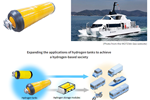Toyoda Gosei develops seawater-derived fiber-reinforced material
Fiber reinforcement is formed from magnesium hydroxide derived from seawater, achieving plastic parts that contributed to improved environmental performance.
Source | Toyoda Gosei
(Kiyosu, Japan) has developed a lightweight material reinforced with fibers that use magnesium hydroxide derived from seawater, in its decarbonization efforts to create lighter weight products leveraging its plastic and rubber materials technology.
In this new plastic material, a magnesium compound derived from seawater is mixed as part of the reinforcing material into a general purpose plastic (polypropylene) used in interior and exterior products. The magnesium compound is fibriform, and so provides greater reinforcement than the previous material (talc), according to the company. As a result, the amount of reinforcing material can be reduced by half, while retaining the same quality as before, contributing to improved environmental performance of vehicles during operation. Another property of the new material is that scratches are less noticeable. This eliminates the need for paint to protect the surface on some products, contributing to a reduction in CO2 during manufacture; Toyoda Gosei cites that in some products, CO2 can be reduced by as much as 70%.
Related Content
-
The potential for thermoplastic composite nacelles
Collins Aerospace draws on global team, decades of experience to demonstrate large, curved AFP and welded structures for the next generation of aircraft.
-
Plant tour: Airbus, Illescas, Spain
Airbus’ Illescas facility, featuring highly automated composites processes for the A350 lower wing cover and one-piece Section 19 fuselage barrels, works toward production ramp-ups and next-generation aircraft.
-
Low-cost, efficient CFRP anisogrid lattice structures
CIRA uses patented parallel winding, dry fiber, silicone tooling and resin infusion to cut labor for lightweight, heavily loaded space applications.



